So in my last post which was practically eons ago (technically, a month) I said I was going to be doing more allergen-free cooking this summer because I’ll have a real kitchen.
And that’s true. I do have a real kitchen. Along with the kitchen, I have some tools a little on the special side. But that’s ok – improvisation is fun!
And though I’ve been harping on chocolate- and dairy-free cheesecake, I’ve had another recipe up my sleeve I’ve been wanting to try for a while: tomato-free spaghetti sauce.
You might wonder if that’s even possible, and I guarantee you, it is. This turned out so close to spaghetti sauce that I don’t even miss the traditional tomato-topped noodles. I searched the Internet for a while looking for recipe ideas, and I found some promising sites. Particularly, this is based off of Gluten Free/Dairy Free NJ’s recipe with changes to the seasonings and steps.
And, yes, I know that this recipe has gasp beets in it! But, seriously, you can’t even really taste them because the flavors all come together, making this greater than its parts.
And the best thing about this recipe? It’s versatile. I portioned some of it out partway through the recipe and ate it as soup for dinner tonight!
Pasta Sauce with Italian Sausage
Sauce Base Ingredients
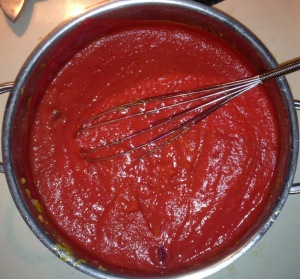 2 medium sweet potatoes (about 4 cups cubed)
2 medium sweet potatoes (about 4 cups cubed)
1 cup carrots (cut into ½ inch slices)
2 teaspoons crushed garlic (about 4 cloves)
1 onion, chopped (I used half of a large sweet Vidalia)
⅓ cup oil, plus a little for sauteing aromatics (I used vegetable oil)
1 T balsamic vinegar
3 T lemon juice
1-8oz can beets
1 T flour
salt
pepper
Seasonings
2 links mild italian pork sausage (I had about half a pound)
½ t salt
½ t onion powder
½ t garlic powder
2 t oregano
2 tiny shakes red pepper
1. Prep all of your vegetables.
2. Remove casings from sausage and crumble it into a large pot. Brown the sausage over medium-high until it is fully cooked. Remove it with a slotted spoon onto a paper-towel lined plate. Keep the sausage grease in the pan. If it’s like mine, there won’t be a lot, but there’ll be enough.
3. Add chopped onion to the pan, cooking it until it’s just starting to brown. Add the garlic and cook until fragrant.
4. Add the sliced carrots, diced sweet potatoes, lemon juice and balsamic vinegar to the onions and garlic. Add some salt and pepper (I put in a couple shakes of pepper and probably about a half teaspoon of salt. Remember: you can always add more spices later). Add water until the veggies are just covered. Bring it up to a boil, then lower the heat, cover and simmer until the vegetables are soft. (Theoretically, this will take 20-30 minutes. I jury-rigged a cover out of some aluminium foil and I think I cut my veggies too big, so mine took forever to soften).
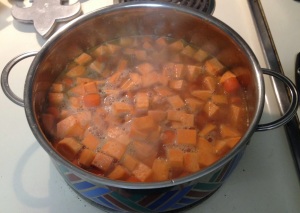
This is from right when I started cooking my veggies. As you
can see, I needed more water in with them. Also, just as a note,
when they’re cooked, there will be a lot less liquid in the pot.
5. In batches, blend the vegetable mixture with the oil. I fought with the blender here at the apartment and managed to bruise my palm. I just used my trusty Magic Bullet … and I managed to leave the bigger cup at home. So I blended my sauce about half a cup at a time. If you don’t have a lot of liquid with your veggies, add some water when blending to get the right consistency. (I also forgot the oil, so I just whisked it into the puree after I returned the mixture to the pot.)
6. Return puree to the pot. At this point, you have root vegetable soup! (If you want to eat is as soup, add salt and pepper and serve. It’s also really good with some shredded pork and romano cheese mixed into the soup.)
- Blend the can of beets (not the can itself, just the beets and their liquid) with the flour. Add the pureed beets to the pot and whisk. Add the crumbled, cooked sausage back to the pot and bring it back up to a simmer.
8. Add the garlic powder, onion powder, oregano, salt and red pepper to the sauce. Simmer for about 5 minutes, then taste and adjust the spices accordingly. Remember: you can always add more of a spice, but you can’t take it away! Make sure you wait several minutes after adding your spices and stirring them in before you taste it so they have enough time to reach their full flavor. They are dried spices after all.
9. Enjoy it! I ate mine over pennette with some sheep’s milk romano cheese. (I can’t eat normal cheese, but the sheep’s milk cheese seems to be ok for me.)
Apparently, other people use the sauce base to substitute for tomatoes in other things, such as salsa and chili. I have yet to try those, but they sound good! (I am a little skeptical on making it into salsa, though…)
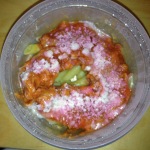 Note: Because of the beet juice, it can dye your pasta pink. This is what mine looked like at work the next day after dishing up my lunch the night before and refrigerating it overnight. Definitely pink noodles and pink cheese. But no worries – it still tasted great!
Note: Because of the beet juice, it can dye your pasta pink. This is what mine looked like at work the next day after dishing up my lunch the night before and refrigerating it overnight. Definitely pink noodles and pink cheese. But no worries – it still tasted great!
Keep reading this blog for more about how to cook delicious, allergen-free food! I’m planning on conquering cheesecake soon, as well as pizza, alfredo sauce and mac-n-cheese. I’ll also be posting some of my favorite smoothie recipes and other cooking adventures.
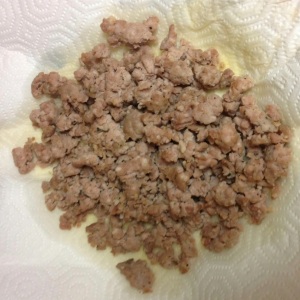
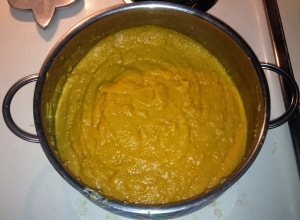
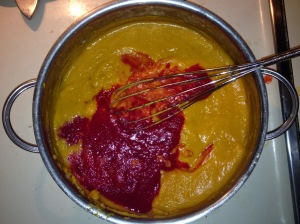
All this sounds like a great idea, everything as fresh as you want it to be. Only question is, why use garlic and onion powder? Thinly sliced garlic, onion, plus oregano, basil, etc. simmered in extra virgin olive oil, then added to the rest of the mixture at the beginning will add more flavor. Plus, the oil adds some body to a spaghetti sauce, as well as being very good for you. A touch of red wine gives it that “kick you in the back of the throat” full bodied taste experience, too. Anyway, really great ideas!!!
Oops, looked over it and saw where you did put chopped onion in. My mistake!
I put in the fresh ingredients in the beginning as part of the sauce base, then the dried spices at the end to add the Italian flavors to make it more like spaghetti sauce. Part of the reason for that is the base (pre-spices) can be used to make other recipes (I've seen it used to make salsa or even chili!) or even just eaten as a pureed vegetable soup. But if I was making all of the recipe into spaghetti sauce, that's a great idea to put the herbs in in the beginning!